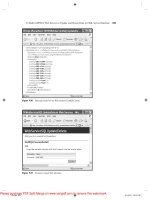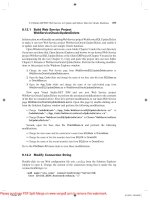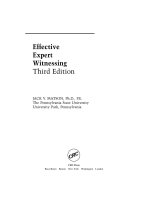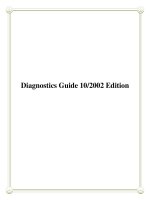Tài liệu Practical C Programming Third Edition pdf
Bạn đang xem bản rút gọn của tài liệu. Xem và tải ngay bản đầy đủ của tài liệu tại đây (10.32 MB, 456 trang )
Practical C Programming
Practical C Programming
Third Edition
Steve Oualline
Beijing
•
Cambridge
•
Farnham
•
Köln
•
Sebastopol
•
Tokyo
Practical C Programming, Third Edition
by Steve Oualline
Copyright © 1997, 1993, 1991 O’Reilly Media, Inc. All rights reserved.
Printed in the United States of America.
Published by O’Reilly Media, Inc., 1005 Gravenstein Highway North, Sebastopol, CA 95472.
Editor, First and Second Editions: Tim O’Reilly
Editor, Third Edition: Andy Oram
Production Editor: Nicole Gipson Arigo
Printing History:
July 1991: First Edition.
August 1992: Minor corrections.
January 1993: Second Edition. Bugs fixed; programs all now conform to ANSI C.
June 1993: Minor corrections.
August 1997: Third Edition.
Nutshell Handbook, the Nutshell Handbook logo, and the O’Reilly logo are registered
trademarks and The Java Series is a trademark of O’Reilly Media, Inc. Practical C
Programming, Third Edition, the image of a cow, and related trade dress are trademarks of
O’Reilly Media, Inc. Many of the designations used by manufacturers and sellers to distinguish
their products are claimed as trademarks. Where those designations appear in this book, and
O’Reilly Media, Inc. was aware of a trademark claim, the designations have been printed in
caps or initial caps.
While every precaution has been taken in the preparation of this book, the publisher assumes
no responsibility for errors or omissions, or for damages resulting from the use of the
information contained herein.
ISBN: 978-1-565-92306-5
[LSI] [2011-02-02]
v
Table of Contents
Preface xv
How This Book is Organized xvi
Chapter by Chapter xvi
Notes on the Third Edition xix
Font Conventions xix
Obtaining Source Code xx
Comments and Questions xxii
Acknowledgments xxii
Acknowledgments to the Third Edition xxiii
I. Basics 1
1. What Is C? 3
How Programming Works 4
Brief History of C 6
How C Works 7
How to Learn C 9
2. Basics of Program Writing 11
Programs from Conception to Execution 11
Creating a Real Program 12
Creating a Program Using a Command-Line Compiler 13
Creating a Program Using an Integrated Development Environment 16
Getting Help on UNIX 33
vi Table of Contents
Getting Help in an Integrated Development Environment 34
IDE Cookbooks 34
Programming Exercises 37
3. Style 38
Common Coding Practices 42
Coding Religion 45
Indentation and Code Format 45
Clarity 46
Simplicity 47
Summary 48
4. Basic Declarations and Expressions 49
Elements of a Program 49
Basic Program Structure 50
Simple Expressions 51
Variables and Storage 52
Variable Declarations 53
Integers 54
Assignment Statements 54
printf Function 56
Floating Point 57
Floating Point Versus Integer Divide 58
Characters 60
Answers 61
Programming Exercises 62
5. Arrays, Qualifiers, and Reading Numbers 63
Arrays 63
Strings 64
Reading Strings 67
Multidimensional Arrays 70
Reading Numbers 71
Initializing Variables 73
Types of Integers 75
Types of Floats 77
Constant Declarations 77
Table of Contents vii
Hexadecimal and Octal Constants 78
Operators for Performing Shortcuts 78
Side Effects 79
++x or x++ 80
More Side-Effect Problems 81
Answers 82
Programming Exercises 83
6. Decision and Control Statements 84
if Statement 84
else Statement 85
How Not to Use strcmp 86
Looping Statements 87
while Statement 87
break Statement 89
continue Statement 90
Assignment Anywhere Side Effect 91
Answer 92
Programming Exercises 93
7. Programming Process 95
Setting Up 97
Specification 98
Code Design 98
Prototype 99
Makefile 101
Testing 104
Debugging 104
Maintenance 107
Revisions 107
Electronic Archaeology 107
Marking Up the Program 108
Using the Debugger 108
Text Editor as a Browser 108
Add Comments 109
Programming Exercises 111
viii Table of Contents
II. Simple Programming 113
8. More Control Statements 115
for Statement 115
switch Statement 118
switch, break, and continue 123
Answers 124
Programming Exercises 125
9. Variable Scope and Functions 127
Scope and Class 127
Functions 130
Functions with No Parameters 134
Structured Programming 135
Recursion 136
Answers 138
Programming Exercises 138
10. C Preprocessor 140
#define Statement 140
Conditional Compilation 146
include Files 148
Parameterized Macros 150
Advanced Features 152
Summary 152
Answers 152
Programming Exercises 154
11. Bit Operations 156
Bit Operators 158
The and Operator (&) 158
Bitwise or (|) 160
The Bitwise Exclusive or (^) 161
The Ones Complement Operator (Not) (~) 161
The Left- and Right-Shift Operators (<<, >>) 162
Setting, Clearing, and Testing Bits 163
Bitmapped Graphics 166
Table of Contents ix
Answers 172
Programming Exercises 172
12. Advanced Types 173
Structures 173
Unions 175
typedef 177
enum Type 178
Casting 179
Bit Fields or Packed Structures 179
Arrays of Structures 181
Summary 182
Programming Exercises 182
13. Simple Pointers 183
Pointers as Function Arguments 188
const Pointers 189
Pointers and Arrays 191
How Not to Use Pointers 195
Using Pointers to Split a String 197
Pointers and Structures 200
Command-Line Arguments 201
Programming Exercises 206
Answers 206
14. File Input/Output 209
Conversion Routines 212
Binary and ASCII Files 215
The End-of-Line Puzzle 216
Binary I/O 218
Buffering Problems 219
Unbuffered I/O 220
Designing File Formats 224
Answers 226
Programming Exercises 227
x Table of Contents
15. Debugging and Optimization 229
Debugging 229
Interactive Debuggers 240
Debugging a Binary Search 244
Runtime Errors 254
The Confessional Method of Debugging 255
Optimization 256
Answers 264
Programming Exercises 264
16. Floating Point 265
Floating-Point Format 265
Floating Addition/Subtraction 266
Multiplication 267
Division 268
Overflow and Underflow 268
Roundoff Error 269
Accuracy 269
Minimizing Roundoff Error 270
Determining Accuracy 270
Precision and Speed 272
Power Series 272
Programming Exercises 275
III. Advanced Programming Concepts 277
17. Advanced Pointers 279
Pointers and Structures 279
free Function 282
Linked List 283
Structure Pointer Operator 286
Ordered Linked Lists 287
Double-Linked Lists 288
Trees 292
Printing a Tree 296
Rest of Program 296
Data Structures for a Chess Program 300
Table of Contents xi
Answers 302
Programming Exercises 303
18. Modular Programming 304
Modules 304
Public and Private 305
The extern Modifier 306
Headers 308
The Body of the Module 310
A Program to Use Infinite Arrays 310
The Makefile for Multiple Files 313
Using the Infinite Array 316
Dividing a Task into Modules 322
Module Division Example: Text Editor 323
Compiler 324
Spreadsheet 325
Module Design Guidelines 327
Programming Exercises 328
19. Ancient Compilers 329
K&R-Style Functions 329
Library Changes 332
Missing Features 333
Free/Malloc Changes 333
lint 334
Answers 334
20. Portability Problems 337
Modularity 337
Word Size 338
Byte Order Problem 338
Alignment Problem 339
NULL Pointer Problem 341
Filename Problems 341
File Types 342
Summary 342
Answers 343
xii Table of Contents
21. C’s Dustier Corners 344
do/while 344
goto 344
The ?: Construct 346
The , Operator 346
volatile Qualifier 346
Answer 347
22. Putting It All Together 348
Requirements 348
Specification 348
Code Design 350
Coding 355
Functional Description 355
Expandability 357
Testing 358
Revisions 359
A Final Warning 359
Program Files 359
Programming Exercises 381
23. Programming Adages 382
General 382
Design 383
Declarations 383
switch Statement 383
Preprocessor 384
Style 384
Compiling 384
Final Note 384
Answer 385
IV. Other Language Features 387
A. ASCII Table 389
B. Ranges and Parameter Passing Conversions 391
Table of Contents xiii
C. Operator Precedence Rules 393
D. A Program to Compute a Sine Using a Power Series 395
Glossary 399
Index 421
Preface
This book is devoted to practical C programming. C is currently the premier
language for software developers. That’s because it’s widely distributed and stan-
dard. Newer languages are available, such as C++, but these are still evolving. C is
still the language of choice for robust, portable programming.
This book emphasizes the skills you will need to do real-world programming. It
teaches you not only the mechanics of the C language, but the entire life cycle of
a C program as well (including the program’s conception, design, code, methods,
debugging, release, documentation, maintenance, and revision).
Good style is emphasized. To create a good program you must do more than just
type in code. It is an art in which writing and programming skills blend them-
selves together to form a masterpiece. True art can be created. A well-written
program not only functions correctly, but is simple and easy to understand.
Comments allow the programmer to include descriptive text inside the program.
When clearly written, a commented program is highly prized.
A program should be as simple as possible. A programmer should avoid clever
tricks. This book stresses simple, practical rules. For example, there are 15 oper-
ator precedence rules in C. These can be simplified into two rules:
1. Multiply and divide come before add and subtract.
2. Put parentheses around everything else.
Consider two programs. One was written by a clever programmer using all the
tricks. The program contains no comments, but it works. The other program is well
commented and nicely structured, but it doesn’t work. Which program is more
useful? In the long run, the broken one. It can be fixed. Although the clever program
xvi Preface
works now, sooner or later all programs have to be modified. The worst thing that
you will ever have to do is to modify a cleverly written program.
This handbook is written for people with no previous programming experience or
programmers who already know C and want to improve their style and reliability.
You should have access to a computer and know how to use the basic functions
such as a text editor and the filesystem.
Specific instructions are given for producing and running programs using the UNIX
operating system with a generic cc compiler or the Free Software Foundation’s gcc
compiler. For MS-DOS/Windows users, instructions are included for Borland C++,
Turbo C++, and Microsoft Visual C++. (These compilers compile both C and C++
code.) The book also gives examples of using the programming utility make for
automated program production.
How This Book is Organized
You must crawl before you walk. In Part I, Basics, we teach you how to crawl.
These chapters enable you to write very simple programs. We start with the
mechanics of programming and programming style. Next, you learn how to use
variables and very simple decision and control statements. In Chapter 7, Program-
ming Process, we take you on a complete tour of the software life cycle to show
you how real programs are created.
Part II, Simple Programming, describes all of the other simple statements and
operators that are used in programming. You’ll also learn how to organize these
statements into simple functions.
In Part III, Advanced Programming Concepts, we take our basic declarations and
statements and learn how they can be used in the construction of advanced types
such as structures, unions, and classes. We’ll also introduce the concept of
pointers. Finally, a number of miscellaneous features are described Part IV, Other
Language Features.
Chapter by Chapter
Chapter 1, What Is C?, gives a brief description of the C language and its use. This
chapter includes some background on the history of the language.
Chapter 2, Basics of Program Writing, explains the basic programming process and
gives you enough information to write a very simple program.
Chapter 3, Style, discusses programming style. Commenting a program is covered,
as well as writing clear and simple code.
Preface xvii
Chapter 4, Basic Declarations and Expressions, introduces you to simple C state-
ments. Basic variables and the assignment statement are covered in detail, along
with arithmetic operators +, -, *, /, and %.
Chapter 5, Arrays, Qualifiers, and Reading Numbers, covers arrays and more
complex variables. Shorthand operators such as ++ and %= are also described.
Chapter 6, Decision and Control Statements, explains simple decision statements
including if, else, and for. A discussion of == versus = is presented.
Chapter 7, Programming Process, takes you through all the necessary steps to
create a simple program from specification through release. Structured program-
ming, fast prototyping, and debugging are also discussed.
Chapter 8, More Control Statements, describes additional control statements.
Included are while, break, and continue. The switch statement is discussed in
detail.
Chapter 9, Variable Scope and Functions, introduces local variables, functions, and
parameters.
Chapter 10, C Preprocessor, describes the C preprocessor, which gives the
programmer tremendous flexibility in writing code. The chapter also provides the
programmer with a tremendous number of ways to mess up. Simple rules that
help keep the preprocessor from becoming a problem are described.
Chapter 11, Bit Operations, discusses the logical C operators that work on bits.
Chapter 12, Advanced Types, explains structures and other advanced types. The
sizeof operator and the enum type are included.
Chapter 13, Simple Pointers, introduces C pointer variables and shows some of
their uses.
Chapter 14, File Input/Output, describes both buffered and unbuffered input/
output. ASCII and binary files are discussed, and you are shown how to construct
a simple file.
Chapter 15, Debugging and Optimization, describes how to debug a program, as
well as how to use an interactive debugger. You are shown not only how to
debug a program, but also how to write a program so that it is easy to debug. This
chapter also describes many optimization techniques for making your program run
faster and more efficiently.
Chapter 16, Floating Point, uses a simple decimal floating-point format to intro-
duce you to the problems inherent in floating point, such as roundoff error,
precision loss, overflow, and underflow.
xviii Preface
Chapter 17, Advanced Pointers, describes advanced uses of pointers for constructing
dynamic structures such as linked lists and trees.
Chapter 18, Modular Programming, shows how to split a program into several
files and use modular programming techniques. The make utility is explained in
more detail.
Chapter 19, Ancient Compilers, describes the old, pre-ANSI C language and associ-
ated compilers. Although such compilers are rare today, a lot of code was written
for them and there are still a large number of programs out there that use the old
syntax.
Chapter 20, Portability Problems, describes the problems that can occur when you
port a program (move it from one machine to another).
Chapter 21, C’s Dustier Corners, describes the do/while statement, the , operator,
and the ? and : operators.
Chapter 22, Putting It All Together, details the steps necessary to take a complex
program from conception to completion. Information-hiding and modular
programming techniques are emphasized.
Chapter 23, Programming Adages, lists some programming adages that will help
you construct good C programs.
Appendix A, ASCII Table, lists the octal, hexadecimal, and decimal representations
of the ASCII character set that is now in almost universal use.
Appendix B, Ranges and Parameter Passing Conversions, lists the limits you can
expect to come up against in handling numbers with various sizes of memory
allocation.
Appendix C, Operator Precedence Rules, lists those impossible-to-remember rules,
to help you when you encounter code written by rude people who didn’t use
enough parentheses.
Appendix D, A Program to Compute a Sine Using a Power Series, illustrates the
manipulation of floating-point (real) numbers, which did not receive complete
attention in the rest of the book.
The Glossary defines many of the technical terms used throughout the book.
Computer languages are best learned by writing and debugging programs.
Sweating over a broken program at 2:00 in the morning only to find you typed “=”
where you should have typed “==” is a very effective learning experience. There
are many programming examples used throughout this book. Some examples
don’t work as expected and are posed as questions for the reader to solve. You
are encouraged to enter each into your computer, run the program, and debug it.
Preface xix
These exercises will introduce you to common errors in short programs so that
you will know how to spot and correct them in larger programs of your own. You
will find answers to questions at the end of each chapter. Also, at the end of many
chapters, you will find a section called “Programming Exercises.” These sections
contain exercises that might be used in a programming class to test your knowl-
edge of C programming.
Notes on the Third Edition
The C language has evolved since the first edition of Practical C Programming
was published. Back then, ANSI compilers were rare and compilers that accepted
the K&R syntax were common. Now the reverse is true.
The third edition reflects the industry shift to ANSI compilers. All programs and
examples have been updated to conform to the ANSI standard. In fact, the older
K&R syntax is discussed only in Chapter 19.
Other changes/additions to the book include:
• Additional instructions for more compilers including a generic UNIX compiler,
the Free Software Foundations gcc compilers, Borland C++, Turbo C++, and
Microsoft Visual C++.
• A completely rewritten Chapter 22. This chapter now uses a statistics program
that should be more relevant to a larger number of readers.
Finally, I am a practical person. I tend to believe that if you know what I mean
and I know what I mean, then the language has served its purpose. Throughout
this book, I use the word “he” to denote a programmer. A few people in the
“Politically Correct” crowd have labeled this practice as sexist. They also have
labeled some passages in the book as being violent or racist.
Please note that when I use “he,” I refer to a programmer, with no regard to
gender. Secondly, when I suggest that some bad programmers should be shot, I
do not speak literally.
My style has always been to communicate things clearly, concisely, and with a bit
of humor. I regret any offense that this might cause anyone.
Font Conventions
The following conventions are used in this book:
Italic
is used for directories and filenames, and to emphasize new terms and
concepts when they are introduced. Italic is also used to highlight comments
in examples.
xx Preface
Bold
is used for C keywords.
Constant Width
is used in text for programs and the elements of a program and in examples to
show the contents of files or the output from commands. A reference in text to
a word or item used in an example or code fragment is also shown in
constant-width font.
Constant Bold
is used in examples to show commands or other text that should be typed
literally by the user. (For example, rm foo instructs you to type “rm foo”
exactly as it appears in the text or example.)
Constant Italic
is used in examples to show variables for which a context-specific substitu-
tion should be made. (The variable filename, for example, would be
replaced by some actual filename.)
“ ”
are used to identify system messages or code fragments in explanatory text.
%
is the UNIX shell prompt.
[]
surround optional values in a description of program syntax. (The brackets
themselves should never be typed.)
. . .
stands for text (usually computer output) that’s been omitted for clarity or to
save space.
The notation CTRL-X or ^X indicates use of control characters. The notation
instructs you to hold down the “control” key while typing the character “x”. We
denote other keys similarly (e.g., RETURN indicates a carriage return).
All examples of command lines are followed by a RETURN unless otherwise
indicated.
Obtaining Source Code
The exercises in this book are available electronically by FTP and FTPMAIL. Use
FTP if you are directly on the Internet. Use FTPMAIL if you are not on the Internet
but can send and receive electronic mail to Internet sites. (This includes
CompuServe users.)
Preface xxi
FTP
If you have an Internet connection (permanent or dialup), the easiest way to use
FTP is via your web browser or favorite FTP client. To get the examples, simply
point your browser to:
/>If you don’t have a web browser, you can use the command-line FTP client
included with Windows NT (or Windows 95). If you are on a PC, you can get
examples.zip instead of examples.tar.gz.
% ftp ftp.oreilly.com
Connected to ftp.oreilly.com.
220 ftp.oreilly.com FTP server (Version 6.34 Thu Oct 22 14:32:01 EDT 1992)
ready.
Name (ftp.oreilly.com:username): anonymous
331 Guest login ok, send e-mail address as password.
Password: username@hostname Use your username and host here
230 Guest login ok, access restrictions apply.
ftp> cd /published/oreilly/nutshell/practical_c3
250 CWD command successful.
ftp> binary
200 Type set to I.
ftp> get examples.tar.gz
200 PORT command successful.
150 Opening BINARY mode data connection for examples.tar.gz (xxxx bytes).
226 Transfer complete. local: exercises remote: exercises
xxxx bytes received in xxx seconds (xxx Kbytes/s)
ftp> quit
221 Goodbye.
%
FTPMAIL
FTPMAIL is a mail server available to anyone who can send electronic mail to, and
receive electronic mail from, Internet sites. Any company or service provider that
allows email connections to the Internet can access FTPMAIL.
You send mail to In the message body, give the FTP
commands you want to run. The server will run anonymous FTP for you, and mail
the files back to you. To get a complete help file, send a message with no subject
and the single word “help” in the body. The following is an example mail message
that gets the examples. This command sends you a listing of the files in the
selected directory and the requested example files. The listing is useful if you are
interested in a later version of the examples. If you are on a PC, you can get
examples.zip instead of examples.tar.gz.
Subject:
reply-to username@hostname (Message Body) Where you want files mailed
open
xxii Preface
cd /published/oreilly/nutshell/practical_c3
dir
mode binary
uuencode
get examples.tar.gz
quit
.
A signature at the end of the message is acceptable as long as it appears after
“quit.”
Comments and Questions
We have tested and verified all of the information in this book to the best of our
ability, but you may find that features have changed (or even that we have made
mistakes!). Please let us know about any errors you find, as well as your sugges-
tions for future editions, by writing to:
O’Reilly & Associates, Inc.
101 Morris Street
Sebastopol, CA 95472
1-800-998-9938 (in US or Canada)
1-707-829-0515 (international/local)
1-707-829-0104 (FAX)
You can also send us messages electronically. To be put on the mailing list or
request a catalog, send email to:
(via the Internet)
To ask technical questions or comment on the book, send email to:
(via the Internet)
We have a web site for the book, where we’ll list examples, errata, and any plans
for future editions. You can access this page at:
/>For more information about this book and others, see the O’Reilly web site:
Acknowledgments
I wish to thank my father for his help in editing and Arthur Marquez for his aid in
formatting this book.
Preface xxiii
I am grateful to all the gang at the Writers’ Haven and Bookstore, Pearl, Alex, and
Clyde, for their continued support. Thanks to Peg Kovar for help in editing.
Special thanks to Dale Dougherty for ripping apart my book and forcing me to put
it together right. My thanks also go to the production group of O’Reilly & Associ-
ates—especially Rosanne Wagger and Mike Sierra—for putting the finishing
touches on this book. Finally, Jean Graham deserves a special credit for putting up
with my writing all these years.
Acknowledgments to the Third Edition
Special thanks to Andy Oram, the technical editor. Thanks also to the production
staff at O’Reilly & Associates. Nicole Gipson Arigo was the project manager. Claire-
marie Fisher O’Leary and Sheryl Avruch performed quality control checks. Mike
Sierra worked with the tools to create the book. Chris Reilley and Robert Romano
fine-tuned the figures. Nancy Priest designed the interior book layout, and Edie
Freedman designed the front cover. Production assistance, typesetting, and
indexing provided by Benchmark Productions, Inc.









